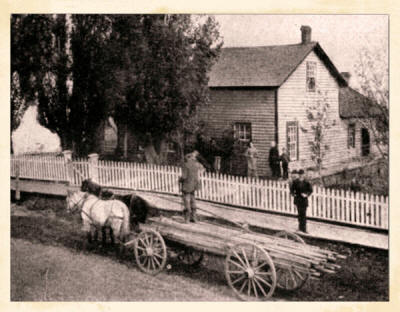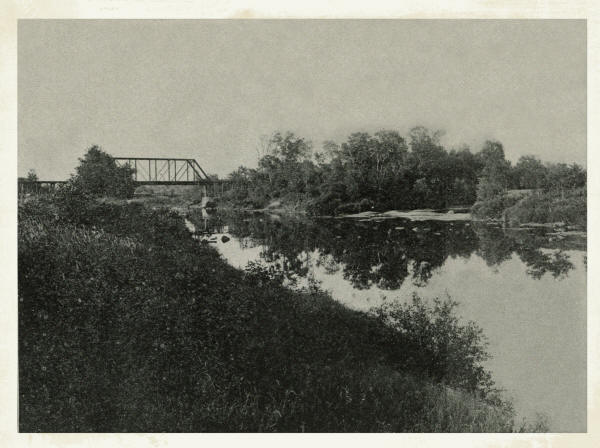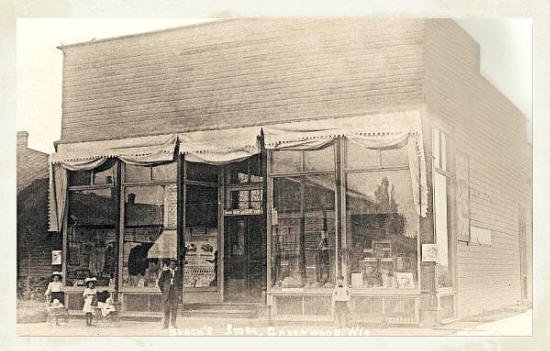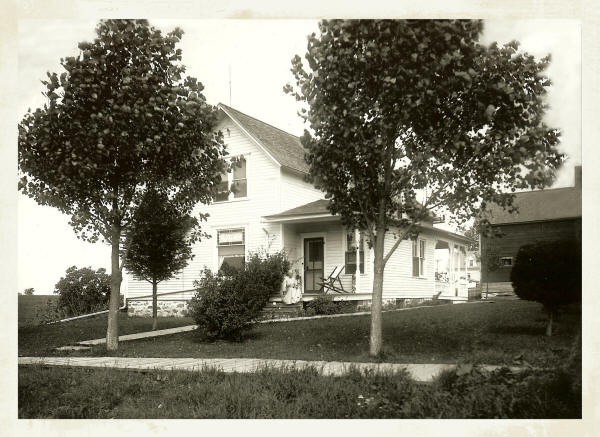
History: Greenwood, Wisconsin (1909) Greenwood Gleaner 29 Jul 1909)
Contact: janet@wiclarkcountyhistory.org
----Source: 1909 Greenwood History, Originally published by Max C. Baldwin in the Greenwood Gleaner, Enhanced and edited and compiled with various photo collections by Janet & Stan Schwarze. Copyright 2008
1909 Greenwood History
Originally published by Max C. Baldwin in the Greenwood Gleaner
Enhanced and edited and compiled by Janet & Stan Schwarze.
Copyright 2008
[1] [2] [3] [4] [5] [6] [7] [8] [9] [10] [11]
Source: Greenwood Gleaner 09/09/1909

The above picture is a birds-eye view of Greenwood as it appears from the south today. It will pay every person who is interested in our beautiful city to watch this page of the Gleaner from week to week, as it is our purpose to give a series of articles in this space every week, dating back to the very first settler who staked his claim, where Greenwood now stands, 55 years ago when not a house or habitation was within a distance of several miles, nothing but a vast wilderness, whose only inhabitants were the wild beasts of the forests and blood thirsty Indians.
This space will contain historic facts which we hope will be of interest to all our readers as well as of educational value to the younger generation. Illustrations especially taken for this purpose will appear each week, and will consist of the business places and industries, residences, picturesque vies, farming and dairy scenes as well as pictures of a few of the oldest settlers in Greenwood.
Our city is now the banner city of Clark County and gaining in popularity and population every year; our farming and dairying sections are the best that can be found in the state; the purest and sweetest water springing up from the ground everywhere; unlimited room for more of the prosperous dairying farms that now surround us, where the sweet, rich, green grass makes an unsurpassed grazing ground and its fertile soil the richest for farm products.
Watch for the opening chapters of an interesting article on greenwood that will continue for 52 weeks and perhaps longer.
Source: Greenwood Gleaner 09/16/1909

The Home of Steven Case Honeywell, built in 1860.
Fifty-Five years ago the land on which there is now thriving one of the most beautiful and progressive little cities to be found in this section of the State of Wisconsin, was a vast wilderness of forests, stretching 16 miles south to the then little town of Neillsville, the county seat of Clark County, and unbroken for miles east, north and west; where hundreds of thousands of acres of huge white pine timbers towered majestically beside the lesser important species of other timbers; where the wary, timid deer and game of every description roamed the wildwood unharmed and unafraid; where the only human inhabitants were an occasional band of roaming Indians or a hunter, who little dreamed of the apparently hidden wealth to be obtained through the agency of the human hands, or who would have though that in so short a period there would be built a thriving city, railroads and thousands of acres of productive farms as there is to be found here today.
But the forests were not to remain in their majestic splendor for long, for in this year, 1854, Elijah Eaton, after whom the town of Eaton in which Greenwood was afterward built, was named, startled the birds and beasts from their undisturbed contentment with the metallic ring of the ax, the sharp zip-zip of the saw and the crash of falling timbers, and who were the first settlers for miles in this section. He and his wife, Olive, located on west side of Black River and there erected a small shanty and sawmill. ("Lige Eaton")
On the 10th day of June, 1857, Charles W. Carpenter blazed a trail from Neillsville, when snow was still on the ground and the ground solidly frozen, the warm rays of the sun being unable to penetrate the deep recesses of the forest with sufficient warmth to thaw out the ground until late summer.
Mr. Carpenter cleared five acres of ground and in the Spring of 1858 built a small shanty of slabs from the Eaton sawmill on the site later occupied by the Oelig residence. When completed, he brought his family, consisting of his wife and two children, to share his humble, but happy home and fortune.
In 1859 he sold his tract of land to Steven Case Honeywell, who was the next settler in Greenwood, and who built the first substantial residence, and which was erected in the year 1860, or the main part of it, the rest of the building being completed in 1862. This property was bought and has, since that time, been occupied by Mrs. Hattie Andrews, better and more familiarly known as “Aunt Hattie.” It was built entirely of hewn logs, and while it was later sided over as it appear above, the original log structure still remains.
The house picture above was also the first inn or hostlery for the accommodation of guests in Greenwood, the upper floor, which was not partitioned off at that time, being used as sleeping quarters in which there were no bed-steads, but where guests rolled themselves up in blankets on the floor in apparent comfort.
The site of our now beautiful and well kept cemetery was then a wilderness, the remains of Elijah Eaton being the first to find a resting place there, and who was later followed by Mrs. S.C. Honeywell, whose remains were carried by four men on a rough, home made stretcher, and for whom a trail had been cut through the forest before the remains could be laid to rest.
Source: Greenwood Gleaner 09/23/1909
Where Rock Creek and Historic Black River Join

Again, going back to the year 1856 and 1857, when there were no settlers at all where Greenwood now stands, also takes the old hunters and settlers of Clark County back to a time that will live forever in the history of the State of Wisconsin.
It was during the winter months of the above years that this section of the state had the heaviest fall of snow ever known in its history, that is to say, that ever covered the ground at one time for any length of time. In November 1856, snow fell steadily for a period of several days, and which measured a depth of four feet during almost all of the winter months, a repetition of this enormous snow fall occurring again in December 1857.
These two winters will go down in history as one of the best for the welfare of hunters that has ever been known. Very near where the Black River and Rock Creek join forces, as seen from a recent picture which is presented above, two handsome deer were slain, not with rifle, but with a common, ordinary club, the deer having become foundered in the deep snow and unable to get away or protect themselves, and the same condition was reported all through this section, hundreds of deer, which could not use their nimble feet, the harp hoofs of which penetrated the crust that would bear the weight of a heavy man on snow-shoes, thus leaving them at the mercy of the hunters, who took advantage of their helplessness to fill their larders for the long cold winter months.
The year before these memorable winters, or in December 1855, mother of one of our oldest settlers, Robert Schofield, paid a visit to this section and the Eaton mill, and who later cleared his tract of land and built a handsome residence, At that time, also, the Eatons were the only inhabitants of this section of Clark County.

E. T. Burch's Store
The handsome and well equipped store of E. T. Burch on Main Street, pictured above, was erected in 1895 by the Greenwood Mercantile and Manufacture Co. with S. P. Jones, F. M. Taylor and E. T. Burch as its officers, and who conducted a general mercantile business until 1902, when its present owner, E. T. Burch, bought out the interests of the parties concerned, taking full possession, and has since conducted a most thriving and praiseworthy business and is one of the most prosperous and respected merchants.
Source : Greenwood Gleaner 09/30/1909

The Home of John Gamble Shanks
Knowing the deep interest our readers are taking in the history of Greenwood which is to occupy this space, it is with deep regret that we are compelled to announce to you that the data for this issue which we have been over a week in trying to obtain, did not arrive until the late mail last night, therefore, we miss this issue rather than to give our readers a disconnected, rambling biographical display that would take us far ahead of our story. We humbly apologize for the disappointment which we know our readers feel.
John Gamble and Margaret Ann (McMahon) Shanks
Source: Greenwood Gleaner 10/07/1909 .
The Home of Frederick and Catherine Pfunder.
Going back to the year 1862, when the home of “Aunt Hattie” was completed, brings us to a time when lumbermen began coming here to work in the Eaton Bros. mill, and between the years 1862 and 1871, four more settlers cleared their tract of land and built their rude but comfortable homes. They were Messrs. Bauman, Steven Andrews, C. Durham and Wm. Begley, the latter of whom was the first to erect a hotel, W.R. Howard & Son, proprietors.
The first store built in Greenwood was erected in the year 1869 (stood where the Catholic Parsonage is now being built), and was operated by Case Honeywell and in 1870 sold to Chandler & Brown, who came here from Black River Falls, and who cleared the ground which is the site near where E. T. Burch’s up-to-date merchandise store now stands, and which was later moved to the rear of the post office building. The year before, 1869, this site, together with the site where White’s Hardware Store and the Presbyterian Church now stand, and, in fact, all that section north and west was still uncleared and practically a wilderness.
Greenwood, which was given it name by Miss Mary Honeywell, now Mrs. Smith Honeywell, daughter of S.C. Honeywell, and which was sent to headquarters to be recorded by Charles Hogue, Oscar Nutting and Frank Brown, was first surveyed June 6th, 1871, when only five houses and one store (named above), was all there was to call a settlement or village.
In the Spring of this year, Homer M. Root, who was a native of Chenango Co., N.Y., and who was at that time extensively engaged in the lumber business, came to Greenwood and cleared a major portion of the property now owned by our Mayor, Hon. John Bushman, who, by hard work and the expenditure of a great deal of time and money, now owns one of the finest farming properties to be found in Clark County.
The winter of 1872-1873 was a memorable one, and one that will go down in the annals of history, on account of the hardships caused by an epidemic which attacked the horses and mules of the lumber camps early in the fall, called “Epizootic,” making them absolutely useless for a period of two weeks, and as all supplies for camps had to be transported from Black River Falls, it would be hard to say what the real hardships were, and which can only be realized by those who were here at that time.
When the “Epizootic” was at its height, the city of Chicago, which had always been black with teams, both horse and mule, was destitute of both; not a horse or mule to be seen for weeks, only ox teams could be seen on the city streets. Matters were about to adjust themselves when small pox, of a very serious nature, broke out in camp, near Greenwood, which added to what must have been a very hard winter for settlers.
Many of our readers will no doubt remember the winter of 1877 – 78 which was called y old-timers the “Al Brown” winter, by reasons of his failure for the amount of $75,000. Failures were numerous on account of the impassibility of the roads, an which also gave this winter the term of “mud winter.” The road to Neillsville was impassable on account of the depth of the mud, and supplies could not be obtained from any other source until early spring.
How little do we dream, when we look out over our broad fields of cultivated farms, handsome residences and commodious barns, which have taken the place of littlie shanties, that so short a time has elapsed sin the hardy, woodsmen, with nothing but endurance, muscle and thrift to back him up, laid the foundation for such a beautiful and thriving little city as Greenwood is today.
[Page 4]
|
© Every submission is protected by the Digital Millennium Copyright Act of 1998.
Show your appreciation of this freely provided information by not copying it to any other site without our permission.
Become a Clark County History Buff
|
|
A site created and
maintained by the Clark County History Buffs
Webmasters: Leon Konieczny, Tanya Paschke, Janet & Stan Schwarze, James W. Sternitzky,
|